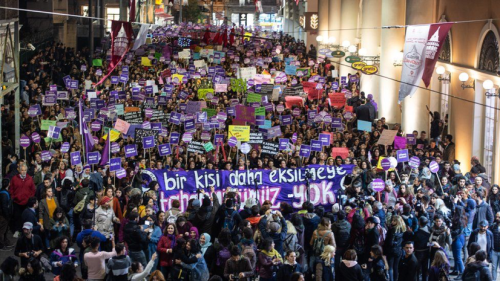
On September 26th, 2019, an earthquake of 5.8 magnitude rocked Istanbul and triggered the alarm of our ANAMED building on Istiklal Caddesi. A metallic voice firmly instructed us to evacuate the building. Two months later, on November 25th, the ANAMED fellows were informed that the main doors of our building would be closed because of a protest march in this same Istiklal street. In the end, the doors were not closed, but the announcement made an impression. Quite surprised by the idea that we should leave our strongly-built cocoon in case of an earthquake but remain inside during a peaceful protest against gender violence, some of us decided to participate in the November 25th protest against gender violence and feminicide.
This march took place in the context of the International Day for the Elimination of Violence against Women, proclaimed by the UN General Assembly in 1999 in order to eradicate all types of violence against women and intentionally celebrated on November 25th, the anniversary of the murder of the Mirabal sisters by Dominican dictator Rafael Trujillo in 1960. In Istanbul, the rally was first authorized, then banned by the Municipality of Beyoğlu, who eventually allowed the march but limited it to a 140 meter long area from Tünel Square, in a “Hesitation Waltz” which unfortunately has become the norm for protests in the general area of Taksim, specifically since the events of Gezi Park in 2013.
As a cisgender male, I don’t feel particularly comfortable in speaking and analyzing the core of the issue, but I want to share here some of my experiences of the event of last Monday. Coming to Istanbul for my research for the past several years and loving this city and its people, I think my relationship with Istanbul should be more than that of “in the bubble” scholars who come here just to use the many academic facilities or to enjoy the museums, music, bars, and restaurants in one of the most fascinating cities in the world.
On November 25th, women defended their rights, asking for law enforcement against gender violence, or simply saying to the patriarchate “Susmuyoruz, korkmuyoruz, itaat etmiyoruz!” (“We are not silent, we are not scared, we are not obeying!”) in the exact city where the Council of Europe’s Convention on Preventing and Combating Violence Against Women and Domestic Violence was signed in May 2011. I wanted to be with them, not as a kind of “orientalist voyeur,” not to protest ironically against violence against women, but simply to support what is also part of the incredible spirit of this city: the vivacity of its people to fight for human (or, its) rights.
On the way from ANAMED to Tünel, where the march began, I started to glimpse what police deployment looks like in this country, even for a peaceful and authorized demonstration. Istiklal Caddesi was unusually empty and on both sides of the street we saw a significant police contingent, most of whom were equipped with shields, helmets, and automatic rifles.
Joining the demonstration’s core in Tünel, we found an atmosphere of fitting wrath and clamorous dignity. The color purple was everywhere: on flags, painted on faces, on banners, and on the placards that had been filled with the names of Turkish victims of gender violence. “Bir kişi daha eksilmeye tahammülümüz yok!” (“We can’t tolerate losing one more person!”), was sung both as a claim and also as a kind of apotropaic mantra. First, feeling a little embarrassed in the middle of this crowd trying to understand what people was saying, I noticed after half an hour that significant groups of students from several universities of the city were protesting with their comrades. To me this suggested that the future of academia, the successors of today’s Turkish scholars, were there. Around us, slogans were chanted and whistles were blown, surrounding us in a powerful cacophony. We hadn’t even begun marching, but the overwhelming noise of the protest rolled down Istiklal street, before astounded tourists and the lenses of news cameras.
The march started quite slowly, due to the crowd, and meter by meter people approached the police force who had moved from the sides of Istiklal to block the center of the pedestrian street. On November 25th, in Istanbul, hope for the disappearance of gender violence peacefully collided with a wall of policemen. On November 25th, in the city of the May 2011 Convention, the march insisting upon the convention’s implementation ended after a little over 100 meters. We reached the 140-meter limit, the 140 meters allowed to the 15 million inhabitants of Istanbul for a protest against what the President of the Republic called “one of the biggest crimes against humanity” on Twitter that very same day.
After half an hour, the organizers decided to call an end to the march. The crowd began to disperse slowly and peacefully, as far as I could see, among some clouds of tear gas.
At that moment I realized that Istanbul was not only the place where I have some of my closest friends, a fascinating history of centrality in economic, cultural, political, and intellectual contexts, a city where I always manage to do my research in incredibly productive ways, and where the vivacity of the academic world and of intellectual life continue to surprise me after so many years. I realized also that Istanbul was still a place where women peacefully protesting gender violence may still meet with violent confrontation.
I don’t exactly know what happened on November 25th, and I don’t really know what to think about those events. As foreigners, we always have to be careful when we try to interpret what occurs in another country, even if we pretend to understand quite well. But as scholars, it is also our duty to become aware of what happens outside our ivory tower, our comfortable libraries, when we cross a gate even if we are unsure if it will still be open when we come return.

